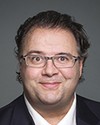I was appointed to be the first president of Shared Services Canada in August 2011. I had been, as a deputy minister, a member of the advisory committee to the Clerk of the Privy Council Office, in advance of that establishment, on the whole administrative services review work, which included the consideration of consolidating IT infrastructure. It was a little bit of a surprise to me in June 2011 when I was invited to be appointed as the president, which happened in August.
It was a big change. As for the rationale behind it, there had been a lot of work done. Mr. Long can tell you all about that, because he was on the administrative services review team and did a lot of the analysis and thinking in advance. Essentially, we were patterning it on work that had been done in the private sector. When Mr. Westcott was at the Canadian Imperial Bank of Commerce, he did something similar in the private sector. One of the reasons that Grant came and joined our team was to help us out with that.
The idea was that the planned consolidation of the IT infrastructure was consolidating at the most generic level of IT. We're not talking about business applications that are different for all departments, but more about a kind of utility. You could consider IT infrastructure to be like the electricity in the walls. It doesn't matter if it's blue, green, red, or purple; if it all works together, is of good quality, and is well integrated, that has a lot of benefits, obviously.
Of course, there are benefits in terms of cost savings. That was a desired outcome from the exercise, but beyond that, there are a lot of other benefits that this exercise continues to seek to achieve. These include the tremendous enabling capacity of a standardized infrastructure to enable a single organization to be inter-operative, to network, and to build the capacity for large amounts of data and for rapid transmission of that data. If you look at private sector companies like IBM, HP, CIBC, and the banks, they have all done this so they can work together as a group. In government, that becomes very important.
That was the rationale behind it. There was a tremendous amount of planning done. Still, it's a huge exercise to take 40 parts of 43 departments and bring them together into a single entity. One of the things that I constantly said in the first year was that 43 was a big number. No matter what you're talking about, 43 is a big number.
Initially, there was a large group of 12,000 employees from what was then Public Works and Government Services, which was the IT shared services branch. They were the initial component of Shared Services Canada in August. Then we spent September, October, and November planning for the rest of the IT people from the other 42 organizations to join us. We had a little bit of time to plan there.
In the first year, the number one priority, absolutely, was maintaining operations. After November 15, when the 5,000 other IT employees were transferred, our main job was making sure that everything kept working, and we were successful in doing that. It was a seamless transition.
The people stayed where they were. They continued to do what they were doing. The only thing that changed was that they were now SSC employees. Our message to them was, please, just keep staying where you are, doing what you're doing, running the same IT infrastructure that you had, the way that you know how to do it.
When people asked me what was a surprise through this initiative, I would often say it was how wonderful the employees were.
We changed so much about the name of their department. We put them what in French you would say l'incertitude la plus totale on November 15. They didn't know this was coming to them individually and yet they continued to come to work, continued to do their best, and continued to work hard on what they had to do. That was our first priority, maintaining operations.
Our second priority was engaging with the employees. We gave 99% of our employees the opportunity for a face-to-face meeting—or for those really remotely located, a meeting by video conference—with Grant and me and the ADMs. We engaged with the industry. We set up a whole process to meet all of the industry associations.









